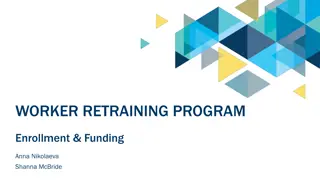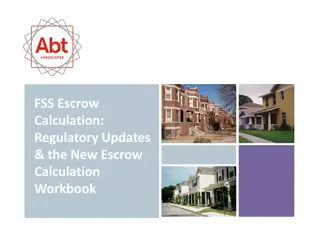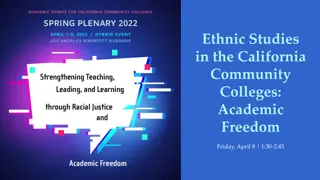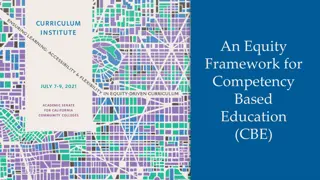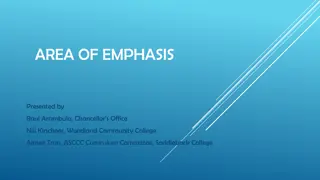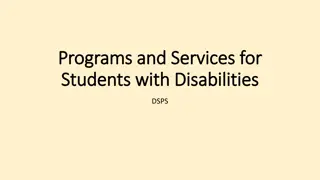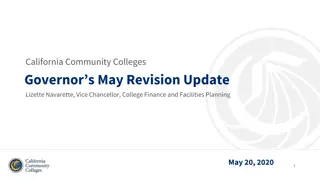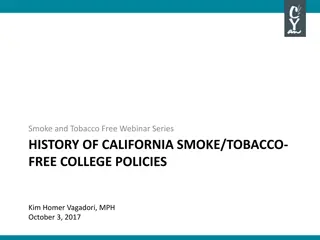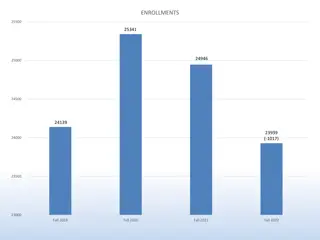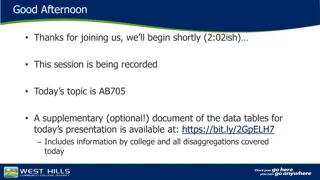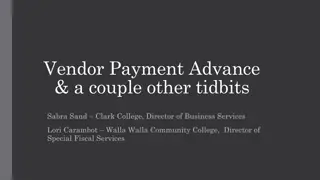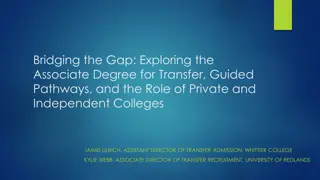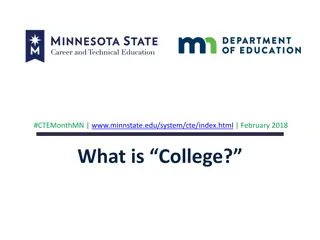Understanding FTES Calculation in California Community Colleges
California Community Colleges use Full-Time Equivalent Students (FTES) to allocate apportionment revenue based on student attendance. FTES calculation involves factors like clock hours, class hours, passing time/breaks, and multiple-hour classes. Understanding these components is essential for educational institutions to receive accurate funding. Authority for FTES calculation comes from California Legislature, Education Code, Board of Governors, and Title 5 of the California Code of Regulations.
Uploaded on Jul 29, 2024 | 0 Views
Download Presentation

Please find below an Image/Link to download the presentation.
The content on the website is provided AS IS for your information and personal use only. It may not be sold, licensed, or shared on other websites without obtaining consent from the author. Download presentation by click this link. If you encounter any issues during the download, it is possible that the publisher has removed the file from their server.
E N D
Presentation Transcript
Calculating and Understanding FTES September 18, 2018 New A&R Directors Training 1
Q: allocated? How is Apportionment Revenue A: On the basis of Full-time Equivalent Students (FTES) in attendance, as reported to the Chancellor s Office on the CCFS- 320 Report three times each year. 2
Full-Time Equivalent Student 1 FTES = 1 student 15 hours per week 2 semesters of 17.5 weeks (3 quarters of 17.5 weeks) = 525 contact hours 3
Sources of Authority California Legislature Education Code Board of Governors of the California Community Colleges Title 5 of the California Code of Regulations 4
FTES Calculation o Clock Hour o Class Hour o Passing time/break o Partial class hour o Multiple hour class 5
Clock Hour A 60-minute time frame that may begin at any time. Examples: 0800 to 0900 0810 to 0910 0820 to 0920 6
Class Hour o A period of not less than 50 minutes of scheduled instruction or examination o There can be only one class hour in each clock hour, except as provided for multiple hour classes. 7
Class Hour o A class hour is commonly called a contact hour or Student Contact Hour. 8
Passing Time/Break o Each clock hour is composed of one class hour segment and a segment referred to as passing time or a break. o No additional attendance may be claimed for the 10-minute segment, except for multiple-hour classes. 9
Multiple Hour Class o A multiple hour class is defined as a class scheduled for more than one clock hour. o The fractional part of a class hour at the end of a multiple hour class is called a partial class hour. 10
Multiple Hour Class o Each 50 minutes exclusive of breaks is a class hour. o A partial class hour beyond the last full clock hour is counted from the 51st minute of the last full clock hour. 11
Multiple Hour Class o No break is allowed in the last full clock hour or the partial class hour. o The divisor for the partial class hour is 50. 12
Multiple Hour Class o Example: 7:00 p.m. to 10:05 p.m. PCH: 9:51 10:05 = 15 min. 15/50 = 0.3 Total Contact Hours: 3.3 13
Calculate the contact hours: Contact hours 1.0 1.0 1.3 2.0 2.0 2.3 2.8 Class meets from 0900 to 0950 0900 to 1000 0900 to 1005 0900 to 1050 0900 to 1100 0900 to 1105 0900 to 1130 14
Attendance Accounting Methods o Weekly Student Contact Hour o Daily Student Contact Hour o Actual Hours of Attendance (Positive Attendance) o Alternative Attendance Accounting Method (Independent Study/Work Experience) o Noncredit Distance Education 15
Weekly Student Contact Hour o Primary terms only o Course coterminous with primary term o Must meet regularly every week of the term o Same number of contact hours each week including TBA hours o No deductions for holidays 16
Census Week o The week nearest to 20% of the number of weeks in the primary term o Census date is Monday of census week o If that Monday is a holiday, census date is the following day 17
Term Length Multiplier o Number of weeks in primary term with at least three days of instruction and/or examination o The term length multiplier for each college is set by the CCC Chancellor s Office based on the college s academic calendar o Maximum TLM: 17.5 for semesters 11.67 for quarters 18
FTES Calculation (WSCH) o Multiply Census Week WSCH by the TLM and divide by 525 FTES = (CWSCH x TLM) / 525 Example: Class meets 3 hours/week 30 students enrolled on Census Day TLM = 17.5 FTES = (3 x 30 x 17.5) / 525 = 3.00 19
Daily Student Contact Hour o Course meets five or more days o Meets the same number of hours on each scheduled day, including any TBA hours o NOT coterminous with primary term o No hours counted for holidays 20
Census Day o The day of the class meeting that is nearest 20% of the number of days the course is scheduled to meet o When the census day falls on the first day the class meets, census is taken on the second day. 21
Course Length Multiplier o Number of days the course is scheduled to meet (CLM) 22
FTES Calculation (DSCH) o Multiply Census Day DSCH by the Course Length Multiplier and divide by 525 FTES = (CDSCH x CLM) / 525 Example: Course meets 2 hours per day 30 students enrolled on Census Day Course meets on 24 days FTES = (2 x 30 x 24) / 525 = 2.74 23
Positive Attendance o Based on actual count of enrolled students present at each class meeting o Courses meeting fewer than five days o Courses irregularly scheduled with respect to the number of days per week or the number of hours on scheduled days o All noncredit courses 24
FTES Calculation (PA) o Divide total hours of actual attendance by 525 FTES = PAH / 525 25
Maximizing FTES for Traditional (Face-to-Face) Classes Best: Weekly Census Second Best: Daily Census Worst: Positive Attendance 26
Alternative Attendance Accounting Method (Independent Study/Work Experience) o WSCH method for courses coterminous with primary term o DSCH method for all other courses 27
Alternative Attendance Accounting Method (Independent Study/Work Experience) o One weekly student contact hours is counted for each unit of credit for which the student is enrolled as of the census date or day. o Lab hours, when appropriate, can be added to the contact hours derived from units of credit 28
FTES Calculation (ISWE) o Until 2002, all distance education courses had to be assigned to the Independent Study/Work Experience attendance accounting method. o Current regulations allow any appropriate accounting method to be used for distance education courses. 29
Distance Education (Credit) o Multiply number of students enrolled as of census by the number of weekly contact hours ; multiply by the Term Length Multiplier; divide by 525. FTES = (# Students x WCH x TLM) / 525 30
Full-Time Equivalent Student (FTES) Reporting Periods First Period: Second Period: January 1 April 15 Third Period: April 16 June 30 July 1 December 31 Reports due: January 15 April 20 July 15 31
When to Report a Section o Attendance for weekly and daily census sections is reported in the period in which the census date falls. o Attendance for positive attendance sections is reported in the period in which the last class meeting occurs. 32
When to Report a Section o Summer Shift Exception: Attendance for daily census sections with census date before July 1 and ending date after July 1 may be reported in either fiscal year. 33
Frequently Observed Errors o Hybrid courses inappropriately assigned to the Weekly Census or Daily Census method o Daily Census courses with weekly lab hours o Summer courses assigned to Weekly Census o Summer courses reported in the wrong year, or reported in both years o Cataloghours reported rather than Schedule hours o TBA hours irregularities 34
Questions? John Mullen Senior Consultant, Fiscal Services California Community Colleges Chancellor s Office jmullen@cccco.edu Mobile: (650) 533-6850 35








